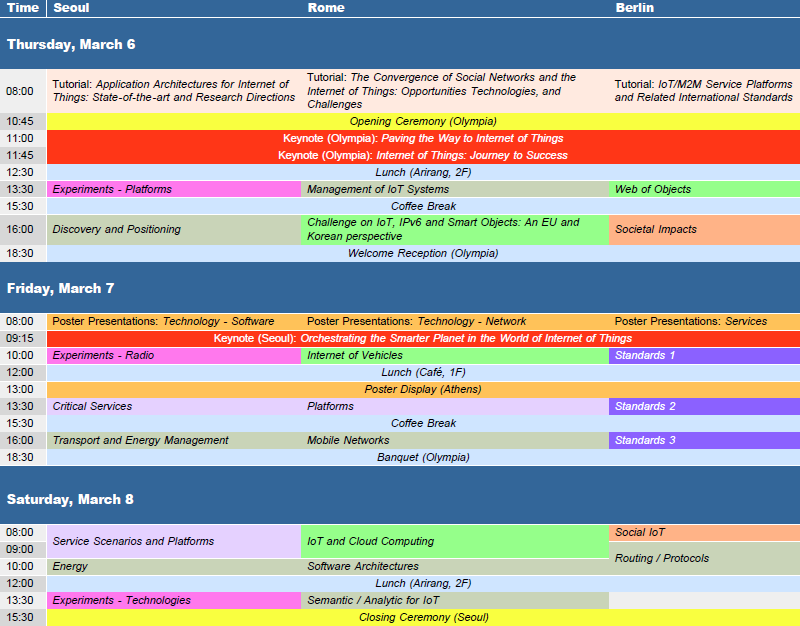Program
View WF-IoT program (PDF)
Program is subject to change.
The proposed program comprises over 100 papers. Papers have been submitted in the following areas:
- Applications and Services (52 submissions)
- Experimental Results (29 submissions)
- Societal Impacts (20 submission)
- Technologies (59 submissions)
- Special Session proposals (3 with 13 papers)
Keynotes
Paving the Way to Internet of Things
Kyungwhoon Cheun (Senior Vice President, DMC R&D Center, Samsung Electronics)
The advent of low-cost, low-profile electronic components is rendering more objects around us to gain intelligence and the ability to communicate via the Internet, hence the Internet of Things (IoT). Business analysts estimate that up to a trillion devices will be equipped with connectivity by 2020, contributing to IoT market potential in the range of tens of trillion of dollars. Meanwhile, Samsung has been driving the IoT revolution through innovations in key components such as CPU, flash, and wireless network equipments for LTE and Wi-Fi. Moreover, Samsung remains one of the leading providers for devices such as Smartphones, Smart TVs, and Wearables, which collectively represent a significant portion of the “Things”. For vertical market solutions, Samsung is actively involved across a wide spectrum of topics such as Smart home, Connected cars, Connected health, Digital signage, and Smart retail. In this talk, we will first assess the current IoT technology, identify key issues and challenges and conclude by illustrating the future R&D direction.
Internet of Things: Journey to Success
Vida Ilderem, Vice President of Intel Labs and Director of the Integrated Platform Research for Intel Corporation
Tens of billions of interconnected devices by 2020, a prediction that is both exciting and challenging that provides rich opportunities for innovation. The technology industry at large is mobilizing and realizing a greater vision for Internet of Things, one that encompasses sensing and sensing platforms, mobile and fixed gateways, analytics and big data, security, manageability, and interoperability. To realize this vision, we need to innovate in many disciplines and drive for common frameworks and standards. This talk will focus on IoT technology innovation challenges and opportunities for this segment of the embedded market.
Orchestrating the Smarter Planet in the World of Internet of Things
Chung-Sheng Li, Director of Commercial Systems, IBM T.J. Watson Research Center
The introduction of pervasive and ubiquitous instrumentation within a smarter planet and internet of things leads to unprecedented real-time visibility of the power grid, traffic, transportation,
water, oil & gas, and personal health. Interconnecting those distinct physical, people, and business worlds through ubiquitous instrumentation, even though still in its embryonic stage, has the potential to unleash a planet that is much greener, more efficient, more comfortable, and safer.
In this talk, we will describe the opportunities and challenges after applying intelligence on interconnected and instrumented worlds and call out the system of systems trend on interconnecting
these distinct but interdependent worlds. It has become increasingly crucial that digital representations of these distinct worlds (a.k.a. models) need to be created as a pre-requisite in order to assess the complexity, maneuver through uncertain environments and eventually achieve the predicted outcome.
The starting point of such an Internet of Things solution is always the real world itself – whether it is smarter grids, buildings, supply chains or water systems. The instrumentation provides a mechanism to facilitate high-fidelity capture of the real world into the observed world, which is often based on models of the real world. These digital representations (or models) facilitate stitching together or assimilating the data captured from the instrumented world and enable interpolation and extrapolation of those areas where data were not available or contaminated. In many cases, these models allow the generation of the most plausible hypothesis to explain the available information. From these models, the expected outcome is generated through simulation and/or predictive analysis. The course of actions based on the models are then taken for command and control (or actuating) the real world.
A smarter planet solution requires optimal or near optimal orchestration of the control flow and information flow. The “music notes” of the orchestration really came from the behavior models
assimilated from the real-world information. Consequently, developing models at the behavior levels is often necessary to facilitate the optimal orchestration of the generation, management,
and continuous assurance of the business outcome.
Standards Session
Full day – organized by Standards Association
Tutorials
| No. | Title | Name | Affiliation |
|---|---|---|---|
| 1 | Application Architectures for Internet of Things: State-of-the-art and Research Directions | Dr. Roch H. Glitho | Associate Professor and Canada Research Chair, Concordia University, Canada |
| 2 | The Convergence of Social Networks and the Internet of Things: Opportunities Technologies and Challenges | Dr. Antonio lera
Dr. Giacomo Morabito, PhD Dr. Luigi Atzori |
Full Professor, University of Reggio Calabria Cagliari, Italy
Associate Professor, University of Catania Cagliari, Italy Assistant Professor, University of Cagliari, Italy |
| 3 | Service Platforms and Related International Standards | Dr. Fuchun Joseph Lin
Dr. Ming Lai |
National Chiao Tung University, Taiwan
Applied Communication Science, USA |


